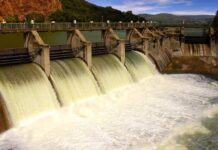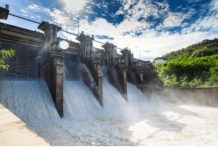Just 0.3 percent of the sunlight that shines on the Sahara and Middle East deserts could supply all of Europe’s energy needs.
The potential for renewable energy development in Africa is experiencing an increase in attention lately as investors and world leaders seek a new clean energy frontier.
The continent could become a gold mine for renewable energy due to abundant solar and wind resources. But roadblocks to clean energy worldwide are amplified throughout the troubled regions of Africa – financial resources are thin and infrastructure is often unreliable.
Meeting at the Africa Carbon Forum in Senegal’s capital Dakar last week, United Nations officials, World Bank specialists, and business leaders exchanged strategies for “Clean Development Mechanism” (CDM) projects on the continent – greenhouse gas-reducing initiatives that industrialized countries can support as a way to compensate for their excess emissions. A theme throughout the meetings was the possibility of future CDM projects under a successor agreement to the Kyoto Protocol, especially if the United States joins the market.
Yet so far, Africa has benefited the least among all continents from the $7 billion annual CDM market. Since the European Union began trading “carbon credits” through its Emissions Trading Scheme in 2005, only 27 of the 1,156 CDM projects included under the scheme have been registered in Africa, Yvo de Boer, executive secretary of the U.N. Framework Convention on Climate Change (UNFCCC), told the carbon forum.
But a World Bank report [PDF] released on Monday provides further evidence of the continent’s potential. Sub-Saharan Africa could provide more than 170 gigawatts of additional power-generation capacity – more than double the region’s current installations – through 3,200 “low-carbon” energy projects, such as combined heat-and-power, biofuels production, mass transportation, and energy efficiency, according to the report.
Together these projects could avoid some 740 million tons of carbon dioxide-equivalent reductions each year. The total capital costs are estimated to be at least $157 billion, the report said. “The pipeline of similar projects in other regions shows us that such projects are often economically viable when carbon revenues are added,” said World Bank senior energy specialist Massamba Thioye, who co-authored the report, in a statement.
A look into the near future suggests the international market still does not consider Africa to be a priority investment region. Sub-Saharan Africa is set to receive only 1.4 percent of the 3,700 CDM projects under way worldwide as of September 1. Furthermore, during the Africa Energy Forum this past June, participants focused almost entirely on fossil fuel-based energy sources, according to World Council for Renewable Energy Chairman Preben Maegaard.
After Maegaard complained that the forum lacked a renewable energy focus, conference director Rod Cargill responded that Africa’s future energy growth is reliant on conventional power sources and that the renewable energy hype has only provided set-backs. “To claim that Africa’s problems of poverty would be alleviated by relying on renewable energy is folly,” Cargill wrote in an e-mail that Maegaard later published. “The number of failed renewable energy projects in Africa over the last 20 years is unacceptable, and verging on the irresponsible. These failed projects have set back development by raising aspirations and then failing to deliver.”
Particularly in sub-Saharan Africa, the electric utility infrastructure necessary for large-scale renewable energy power plants is lacking. In Kenya, for instance, at least 50 power outages occur each year.
Across the region, 500 million people lack access to electricity. “African countries will need to spend at least six percent of their GDP on energy over the next 10 years to keep up with their economic growth.
It is therefore clear that a number of technologies (both traditional and new) will need to be applied,” said Dana Rysankova, a World Bank senior energy specialist for Africa, in the report’s press release.
But grand renewable energy schemes are still being drawn.
A researcher from the European Commission’s Institute for Energy reported earlier this year that 0.3 percent of the sunlight that shines on the Sahara and Middle East deserts could supply all of Europe’s energy needs. British Prime Minister Gordon Brown and French President Nicolas Sarkozy have supported plans to build a 45 billion Euro ($64 billion) “super grid” that would connect renewable energy resources across Europe and Africa.
Along the Great Rift Valley – a 6,000 kilometer terrain stretching from Syria to Mozambique – a huge amount of untapped geothermal energy may soon be developed. In June, Kenya announced that it would install some 1,700 megawatts of geothermal capacity within the next 10 years – 150 percent of the country’s total electricity generating capacity. Djibouti plans to supply nearly all of its electricity needs through geothermal energy, with the help of Reykjavik Energy Invest and the World Bank.
At the Senegal convention, among the plans announced were a solar-powered university in Nigeria, biofuels development in the Ivory Coast, and a wind farm in Senegal. Biofuel production from jatropha, a drought-resistant oilseed bush, could provide the most opportunities if the plant can be effectively domesticated and its energy conversion rate improves. The World Bank report counted 555 potential jatropha projects in sub-Saharan Africa.












































